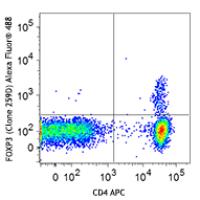-
Sign In
-

-
 Sony Biotechnology
Sony Biotechnology
-

-
 Sony Biotechnology
Sony Biotechnology
Alexa Fluor® 488 anti-human FOXP3
Antibodies Single
Sony
259D
Flow Cytometry
Mouse IgG1, κ
Human
Full-length FOXP3 protein
2201055
$162.00
Description
FOXP3 is a 50-55 kD transcription factor, also known as Forkhead box protein P3, Scurfin, JM2, or IPEX. It is proposed to be a master regulatory gene and more specific marker of T regulatory cells than most cell surface markers (such as CD4 and CD25). Transduced expression of FOXP3 in CD4+/CD25- cells has been shown to induce GITR, CD103, and CTLA4 and impart a T regulatory cell phenotype. FOXP3 is mutated in X-linked autoimmunity-allergic dysregulation syndrome (XLAAD or IPEX) in humans and in "scurfy" mice. Overexpression of FOXP3 has been shown to lead to a hypoactive immune state suggesting that this transcriptional factor is a central regulator of T cell activity. In human, unlike in mouse, two isoforms of FOXP3 have been reported: one (FOXP3) corresponding to the canonical full-length sequence; the other (FOXP3 δ2) lacking exon 2. The 259D antibody recognizes human FOXP3 epitope in the region of amino acids 105-235.
Formulation
Phosphate-buffered solution, pH 7.2, containing 0.09% sodium azide and 0.2% (w/v) BSA (origin USA).Recommended Usage
Each lot of this antibody is quality control tested by intracellular flow cytometry . For flow cytometric staining, the suggested use of this reagent is 5 microL per 106 cells in 100 microL volume. It is recommended that the reagent be titrated for optimal performance for each application.
* Alexa Fluor® 488 has a maximum emission of 519 nm when it is excited at 488 nm.
References
1. Roncador G, et al. 2005 Eur. J. Immunol. 35:1681.
2. Yang ZZ, et al. 2006. Blood 107:3639. PubMed
3. Gavin MA, et al. 2006. P. Natl. Acad. Sci. USA 103:6659. PubMed
4. Groh V, et al. 2006. Nature Immunology 7:755. PubMed
5. Tran DQ, et al. 2007. Blood doi:10.1182/blood-2007-06-094656.PubMEd
6. Long SA, et al. 2008. J Autoimmun. 30:293. PubMed
7. Gong G, et al. 2009. Blood 113:837. PubMed
8. Long SA, et al. 2009. Eur J. Immunol. 39:612. PubMed
9. Long SA, et al. 2010. Diabetes. 59:407. PubMed
10. Ferraro A, et al. 2014. PNAS. 111:1111. PubMed
11. Vudattu NK, et al. 2014. J Immunol. 193:587. PubMed
12. Dupont G, et al. 2014. Cytokine. 69:146. PubMed


